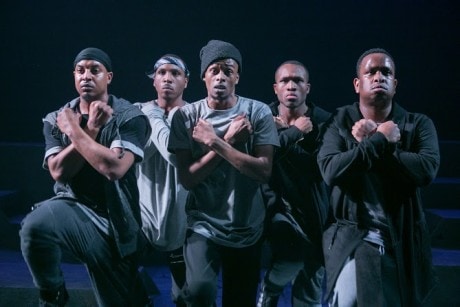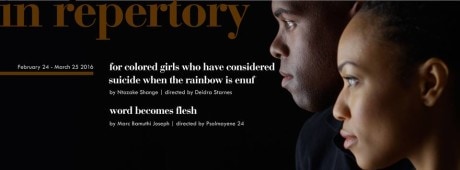There is a critical conversation going on in Anacostia right now that may be one of the most urgent and honest exchanges between black women and black men the American theater has ever known.
The conversation is between two choreopoems, one composed and staged from a black man’s point of view (Marc Bamuthi Joseph’s Word Becomes Flesh, directed by Psalmayene 24) and one composed and staged from a black woman’s point of view (Ntozake Shange’s classic for colored girls who have considered suicide/when the rainbow is enuf, directed by Deidra Starnes).
In a brilliant stroke of programming, Theater Alliance has presented these two works in repertory. When I went to see them yesterday, first Word Becomes Flesh followed by for colored girls…, I expected to review them separately. I knew right away afterward I couldn’t. They say too much to each other and together. And what they say is so personal and profound that it resonates with an importance beyond its powerful parts.

Word Becomes Flesh is the poet’s voice of one young black man performed in the voices of an agile and emotion-baring ensemble of five: Louis E. Davis, Chris Lane, Clayton Pelham, Gary L. Perkins III, Justin Weaks. Speeches, riffs, raps, and slam fragments are shared, split up, echoed, amplified. Singly and as a chorus their bodies (choreographed by Tony Thomas) physicalize their aspirations and the emergency of their lives. The effect is gripping.
An early refrain sets the tone of heartrending storytelling in a world hazardous to “brown boys”:
Everyday beginswith a black manon the run.Early to rise, early to runJust in case the polices come
A narrative emerges about an unnamed young man whose father abandoned him. We follow him as he pursues “the scent of potential sex” to its exultant consummation with a young woman he gets pregnant. We follow him as he is emotionally torn apart between wanting to abandon his unborn son like his own father did and, alternately, facing up to what it will mean to raise a boy whose life will be in ceaseless jeopardy “in the land of the free by the blood of the slave”:
Only 5 months in the womb we’ve been hunted for so long my son
My son are you going to be hunted too
The personal narrative becomes ever more intense. Lighting by William K. D’Eugenio frames each electric scene shift. Sound design and original music by Nick tha Ida underscores each heartfelt raw beat of the words. Flashes of wit and warmth come as a joy and a jolt, but the harsh stories being told about a black man’s life in “the system” don’t let go. Each of the ensemble members has a stunning solo turn and there’s an extended one by Jeffrey Weaks—which includes an agonizing-to-watch passage about not wanting to be black—that absolutely astounds.
At the end comes an image of extraordinary transcendence. There can be no mistaking in that moment the hope and love that became Word Becomes Flesh.
RATING:
______

I remember seeing for colored girls who have considered suicide/when the rainbow is enuf at the Public Theater in New York just before it opened on Broadway in 1976 (becoming only the second play by a black woman to do so; Lorraine Hansberry’s A Raisin in the Sun was first). I remember the mostly female audience’s excitement around the thrust stage as Shange’s unabashed homage to sisterhood and female self-empowerment unfolded. (In those early days of second-wave feminism, for colored girls… was viewed as a breakthrough for all women; there was as yet nothing like it in commercial theater.) The horrifying story told in the poem “a nite with beau willie brown” has never left me. Seeing that scene in the new Theater Alliance production gave me chills all over again.
What was breakthrough about for colored girls… was not only its celebration of self-love (“I found god in myself and I love her fiercely”). It was the authenticity—both wickedly funny and brutally frank—of its depiction of women’s relationships with men. For women who’ve been there, done that, every poem in the piece offers a “remind you of anything?” recognition scene. Men’s passion and fascination, fecklessness and faithlessness, unkindness and cruelty—it’s all there, divvied up among the vigorous voices of women clothed in vivacious colors of the rainbow, in free verse as razor sharp as it is rhapsodic.
Director Deidra Starnes performed in a production of for colored girls… directed by Shange herself, and every detail of this production bespeaks Starnes’ deep-inside connection to each meter and meaning in the script.
To declaim and dance to life this rich text on the Anacostia Playhouse stage, Starnes has assembled a cast of seven who are simply phenomenal—Christa Bennett, Kashayna Johnson, Naomi LaVette, Alina Collins Maldonado, Lolita Marie, Sharisse Taylor, and Natalie Tucker. Each gives outstanding performances of their solo poems—Natalie Tucker’s hilarious and touching delivery of “somebody almost walked off wid alla my stuff” almost stopped the show, and Kashayna Johnson’s delivery of “a nite with beau willie brown” was heart-stopping.
Lighting Designer Dan Covey beautifully highlights their every hue and cry. Sound Designer David Lamont Wilson interjects lovely tunes. And Choreographer Sandra L. Holloway shapes these wonderful women’s magnificent moves. That Theater Alliance has revived for colored girls… in such a fine production, in such a sensitive interpretation, with such sensational performances, gives every reason one might need not to miss seeing it on its own. But there’s even more reason to see it with Word Becomes Flesh.
The text used in Theater Alliance’s for colored girls… is the version Shange updated in 2010 to add stories of a woman’s relationship with a PTSD-affected Gulf War vet and another woman’s relationship with an HIV-infected man. What’s striking about these two inclusions is that they reference societal perils with more specificity than did the play in its original incarnation. Back in the 1970’s, the world of for colored girls… was a world of women and the men in it. Its scope was never the world their men were in. And that’s what makes Theater Alliance’s pairing of these two plays so groundbreaking and such a peak instance of theater’s potential to inspire conversation.
The two casts of these two plays stand on the same stark stage—multilevel gray slabs designed by Ethan Sinnott. They wear costumes by the same designer, Marci Rodgers (hip-hop athletic wear for the men, gorgeous gowns for the women). But the most significant fact about them is that, implicitly, their characters now inhabit the same world. One doesn’t necessarily know that watching the plays one at a time. In Word Becomes Flesh, the women in these men’s lives are mostly offstage and we don’t hear from them (except briefly when they’re mimicked). In for colored girls… the men in these women’s lives are mostly offstage and we don’t hear from them (except briefly when they’re mocked). But there’s something about the performances that is sure to share a time and place in one’s mind afterward.
I asked both directors about it, because I had such a strong sense that there was deep accord between the two productions. Turns out that from the very first table read when both casts were in the room the whole time, they have been collaborating behind the scenes in a generosity of mutual support that has included watching each other’s runs. From the get-go, these directors and these actors intended that the women given voice by Ntozake Shange and the men given voice by Marc Bamuthi Joseph would hear what each other was saying via the memory and imagination of each theatergoer who attends to both.
I have never seen a double bill that comes anywhere near doing what these two paired plays do. I have never before experienced such great theater in the interstice and implicit cohesion between two such singularly powerful works.
RATING:
Word Becomes Flesh
Running Time: 60 minutes, with no intermission.
Word Becomes Flesh plays through March 26, 2016, at Theater Alliance, performing at The Anacostia Playhouse – 2020 Shannon Place SE, in Washington, DC. For tickets, purchase them online.
for colored girls who have considered suicide/when the rainbow is enuf
Running Time: 90 minutes, with no intermission.
for colored girls who have considered suicide/when the rainbow is enuf plays through March 26, 2016, at Theater Alliance, performing at The Anacostia Playhouse – 2020 Shannon Place SE, in Washington, DC. For tickets, purchase them online.
Note:
In repertory weekday evenings. On Saturdays both plays are performed and ticketed separately. On Sundays both plays are performed as a double bill with a 15-minute intermission.
RATING:






An outstandingly heartfelt and sensitively expressed review, worthy of the best in theatrical criticism. I found myself reliving performances of “For Colored Girls” that I’ve seen through the years in your text and compelled to see the partner play “Word Becomes Flesh.” I’ll recommend to Ms. Shange that we see this double-bill if we can fit it into the calendar—Donald Sutton, President; Global Artists Management of NY, Inc.; Personal Manager: Ntozake Shange.